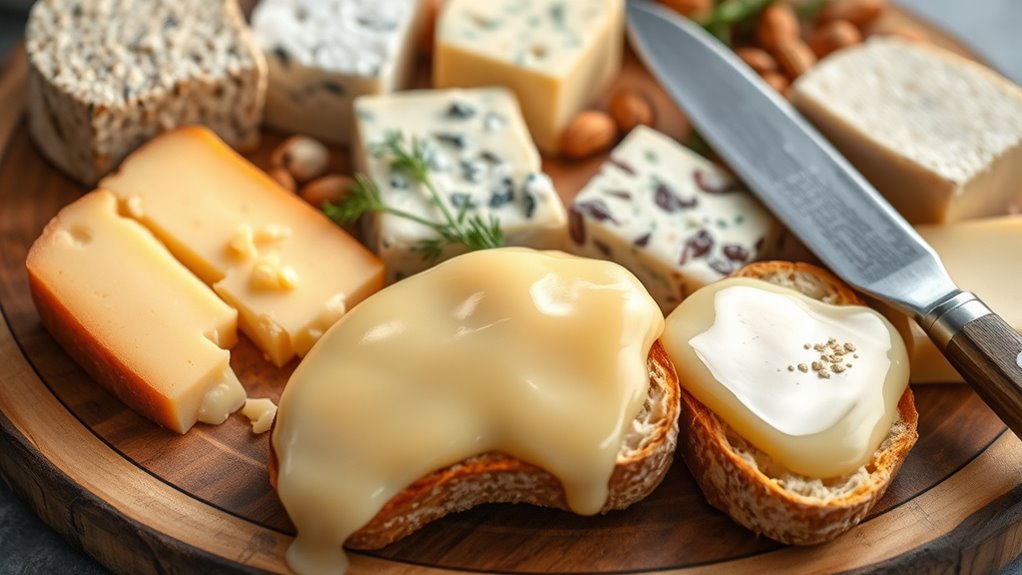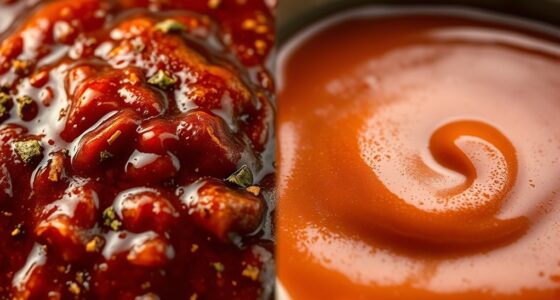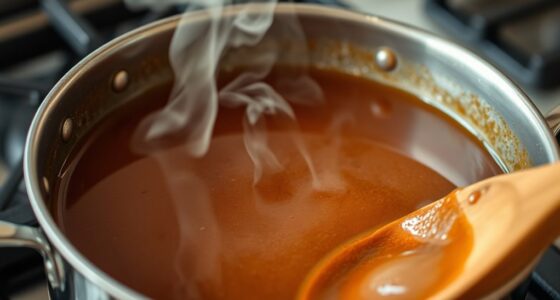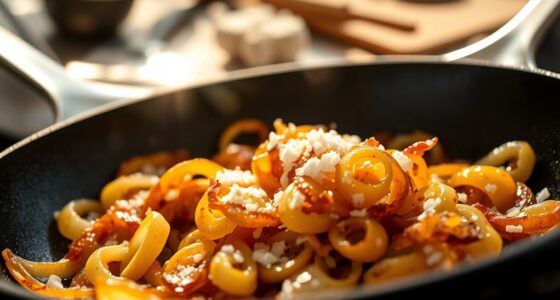To guarantee your cheese melts right, choose cheeses with high moisture and fat content like mozzarella, fontina, or Havarti, which melt smoothly and evenly. Soft, young cheeses work best for gooey textures, while blending bold cheeses like aged gouda or blue cheese with milder options creates great flavor balance. Experiment with small amounts first to find the perfect mix for your dish. Keep exploring to master the art of cheese melting and elevate your recipes.
Key Takeaways
- Use cheeses with high moisture and fat content, like mozzarella, fontina, or Havarti, for smooth, creamy melts.
- Combine mild, melting cheeses with sharper or aged cheeses to balance flavor and meltability.
- Start with small cheese amounts and gradually increase to achieve desired texture and flavor.
- Pair melting cheeses with drier, crumbly cheeses to enhance flavor without compromising melt quality.
- Avoid using highly aged or low-moisture cheeses alone, as they tend to become oily or crumbly when melted.
Top Tips for Choosing Melting Cheese Blends
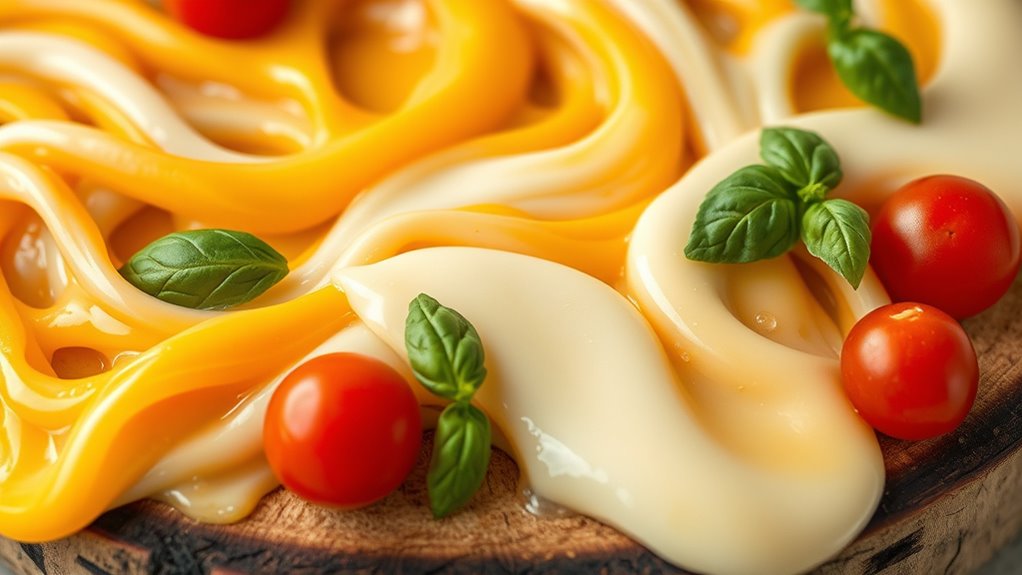
When it comes to creating the perfect melted cheese, choosing the right blend is essential. The key lies in understanding how different cheeses combine their melting properties and flavor profiles to produce a smooth, flavorful finish. Not all cheeses melt the same way, so selecting the right combination can make or break your dish. For example, some cheeses have excellent melting properties, creating a creamy, cohesive texture, while others tend to become greasy or stringy. Sharp, aged cheeses often don’t melt as smoothly, whereas softer cheeses like mozzarella or young cheddar tend to melt perfectly, providing that desirable gooey consistency.
Your goal should be to balance melting qualities with flavor. If you’re after a rich, indulgent taste, consider mixing cheeses with bold flavor profiles like blue cheese or aged gouda. However, these cheeses might not melt as seamlessly on their own. Combining them with milder cheeses such as Monterey Jack or mozzarella can help achieve a silky texture without sacrificing flavor complexity. Additionally, the fat content of the cheese influences melting behavior; higher-fat cheeses usually melt more smoothly and evenly. This is why cheeses like Havarti or fontina are popular choices—they have high moisture and fat content that promote excellent melting properties.
Another aspect to keep in mind is how the cheese’s moisture content affects melting. Cheeses with higher moisture levels tend to melt more readily, creating a luscious, creamy consistency, while drier, aged cheeses can become crumbly or oily when heated. For ideal results, blend cheeses with similar moisture levels to ensure a uniform melt. When experimenting with cheese blends, start with small amounts and gradually increase until you reach the desired texture and flavor balance.
Understanding how different cheeses behave during melting gives you more control over your dish. For instance, if you’re making a cheese sauce, combining a melting cheese like mozzarella or fontina with a sharper, flavorful cheese can provide both richness and depth. When melting cheese for sandwiches or gratins, choose cheeses that melt smoothly and complement the other ingredients. Ultimately, your success depends on knowing which cheeses possess favorable melting properties and how their flavor profiles will enhance your dish.
Frequently Asked Questions
Can I Substitute Different Cheeses in Melting Blends?
Yes, you can substitute different cheeses in melting blends, but keep in mind cheese flavor variations and texture adjustments. Softer cheeses like mozzarella melt smoothly, while harder cheeses like cheddar add sharpness. If you swap cheeses, adjust the ratios to maintain the desired meltiness and flavor. Experimenting with different cheese combinations helps you tailor the melt and taste to suit your dish perfectly.
How Do I Prevent Cheese From Becoming Greasy When Melting?
Coincidentally, preventing greasy cheese when melting starts with paying attention to cheese texture and melting techniques. You should choose cheeses with lower fat content, like mozzarella or Monterey Jack, and grate them finely for even melting. Use gentle heat, stirring constantly, and avoid high temperatures that cause fat separation. Adding a splash of acid, such as lemon juice or vinegar, can also help maintain a smooth, non-greasy consistency.
Are There Dairy-Free Options for Melting Cheese Blends?
Yes, there are dairy-free alternatives for melting cheese blends. You can try vegan cheese options like cashew-based cheeses, coconut oil blends, or commercially available dairy-free cheeses designed to melt well. These options work great for recipes that require melted cheese, providing a similar creamy texture without dairy. Just keep in mind that melting behavior varies, so experiment with different brands and types to find the best dairy-free option for your needs.
What’s the Best Way to Store Leftover Melting Cheese?
Think of leftover melting cheese as a treasure you want to keep fresh. Store it in an airtight container or tightly wrap it with plastic wrap to prevent air from sneaking in. Keep the cheese in the fridge, ideally within two hours of melting, to maintain its flavor and texture. Proper cheese storage is key for leftover preservation, ensuring your cheesy delights stay flavorful and ready for your next craving.
How Does Age Affect Cheese’s Melting Quality?
As cheese ages, its melting quality often decreases because of flavor development and moisture loss. Young cheeses melt smoothly, making them ideal for dishes, while aged cheeses develop complex flavors but tend to be firmer and less meltable. You notice this difference in texture and meltability, so choose your cheese based on whether you prioritize flavor or melting ability. Fresh cheeses are better for melting, whereas aged cheeses shine in flavor.
Conclusion
Now that you know what to look for, choosing the perfect melting cheese blend becomes easy. Think of it like assembling a puzzle—each cheese adds its unique touch, creating a smooth, gooey masterpiece. Whether you’re making a cheesy dip or topping your favorite dish, trust your instincts and experiment. With these tips, you’ll craft melt-worthy creations that are just as delightful as they are cheesy. Happy blending!
